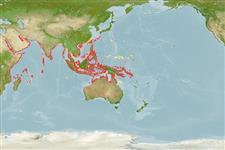Teleostei (teleosts) >
Eupercaria/misc (Various families in series Eupercaria) >
Lutjanidae (Snappers) > Lutjaninae
Etymology: Lutjanus: Malay, ikan lutjan, name of a fish.
More on author: Peters.
Environment: milieu / climate zone / depth range / distribution range
Ecology
Marine; freshwater; brackish; reef-associated; depth range 5 - 20 m (Ref. 9710). Tropical; 30°N - 18°S, 31°E - 165°E (Ref. 55)
Indo-West Pacific: Red Sea and East Africa to the Solomon and Mariana islands.
Length at first maturity / Size / Weight / Age
Maturity: Lm 20.1, range 12 - ? cm
Max length : 35.0 cm TL male/unsexed; (Ref. 55); common length : 20.0 cm TL male/unsexed; (Ref. 55)
Dorsal spines (total): 10; Dorsal soft rays (total): 13 - 14; Anal spines: 3; Anal soft rays: 7 - 9. This species is distinguished by the following characters: body moderately deep; greatest depth 2.5-3.0 in SL; preopercular notch and knob poorly developed; vomerine tooth patch triangular, with a medial posterior extension; gill rakers of first gill arch 6-7 + 10-14 - 16-21; caudal fin truncate to slightly emarginate; scale rows on back parallel to lateral line. Colour of back and upper sides dark brown, lower sides and belly whitish with a silver sheen; usually a series of 4-5 narrow yellow stripes on the sides below the lateral line; a distinct round, black spot on the back below the posterior part of the spinous portion of the dorsal fin (Ref. 9821, 90102).
Adults inhabit very shallow coastal habitats, often in large schools near freshwater run-offs (Ref. 48635). Juveniles often intertidal (Ref. 48635); over sand, silt, or coral rubble bottoms, occasionally in mangrove-lined streams and estuaries (Ref. 9821) They may enter freshwater to feed (Ref. 245); on small fish and invertebrates (Ref. 5213). This is a small species commonly utilized in subsistence fisheries and also seen in markets. Caught mainly with handlines, traps, and gill nets and are marketed mostly fresh (Ref. 9821).
Life cycle and mating behavior
Maturities | Reproduction | Spawnings | Egg(s) | Fecundities | Larvae
Allen, G.R., 1985. FAO Species Catalogue. Vol. 6. Snappers of the world. An annotated and illustrated catalogue of lutjanid species known to date. FAO Fish. Synop. 125(6):208 p. Rome: FAO. (Ref. 55)
IUCN Red List Status (Ref. 130435)
Threat to humans
Harmless
Human uses
Fisheries: minor commercial
Tools
Special reports
Download XML
Internet sources
Estimates based on models
Preferred temperature (Ref.
123201): 25.9 - 29.3, mean 28.6 °C (based on 2891 cells).
Phylogenetic diversity index (Ref.
82804): PD
50 = 0.5000 [Uniqueness, from 0.5 = low to 2.0 = high].
Bayesian length-weight: a=0.01622 (0.01048 - 0.02510), b=2.95 (2.83 - 3.07), in cm total length, based on LWR estimates for this species & Genus-body shape (Ref.
93245).
Trophic level (Ref.
69278): 3.6 ±0.53 se; based on food items.
Generation time: 4.4 ( na - na) years. Estimated as median ln(3)/K based on 2
growth studies.
Resilience (Ref.
120179): High, minimum population doubling time less than 15 months (Preliminary K or Fecundity.).
Fishing Vulnerability (Ref.
59153): Low vulnerability (19 of 100).
Nutrients (Ref.
124155): Calcium = 56.1 [33.6, 96.4] mg/100g; Iron = 0.49 [0.30, 0.85] mg/100g; Protein = 18.8 [17.3, 20.2] %; Omega3 = 0.137 [0.085, 0.225] g/100g; Selenium = 51 [28, 92] μg/100g; VitaminA = 153 [28, 664] μg/100g; Zinc = 0.563 [0.396, 0.837] mg/100g (wet weight);
